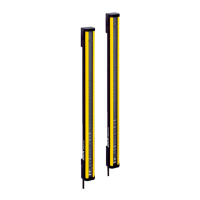Requirements for the electrical control of the machine
T
he two outputs are short-circuit protected against 24 V DC and 0 V. When the protec‐
tive field is clear, the OSSDs are in the ON state and the signal level is HIGH (non-iso‐
lated). In the event of an interruption in the light path or device fault, the OSSDs are in
the OFF state and the signal level is LOW (above 1.5 kΩ to 0 V).
The safety light curtain complies with the rules for electromagnetic compatibility (EMC)
for the industrial sector (Radio Safety Class A). Radio interference cannot be ruled out
when used in residential areas.
DANGER
Hazard due to lack of effectiveness of the protective device
In the case of non-compliance, it is possible that the dangerous state of the machine
may not be stopped or not stopped in a timely manner.
b
Make sure that the following control and electrical requirements are met so that
the safety light curtain can fulfill its protective function.
•
The external voltage supply of the safety light curtain must be capable of jumper‐
ing a brief power failure of 20 ms as specified in IEC 60204-1.
•
The power supply unit must ensure safe isolation according to IEC 61140
(SELV/PELV). Suitable power supply units are available as accessories from SICK,
see "Accessories", page 64.
4.4.1 Restart interlock
Overview
D
epending on the regulations which apply at the place of installation, a restart interlock
may be required.
The restart interlock prevents the machine from automatically starting up, for example
after a protective device has responded while the machine is operating or after chang‐
ing the machine’s operating mode.
The safety light curtain does not have an internal restart interlock. If required, a restart
int
erlock must therefore be implemented externally via the circuitry or the control, e.g.,
in connection with the SICK switching amplifier UE48-2OS/UE48-3OS.
Principle of operation
The restart interlock prevents the machine from automatically starting up, for example
after a protective device has responded while the machine is operating or after chang‐
ing the machine’s operating mode.
Before the machine can be restarted, the operator must reset the restart interlock.
Figure 15: Schematic representation of operation with restart interlock
PROJECT PLANNING 4
8014253/ZOH3/2017-08-04 | SICK O P E R A T I N G I N S T R U C T I O N S | deTec4 Core
25
Subject to change without notice

